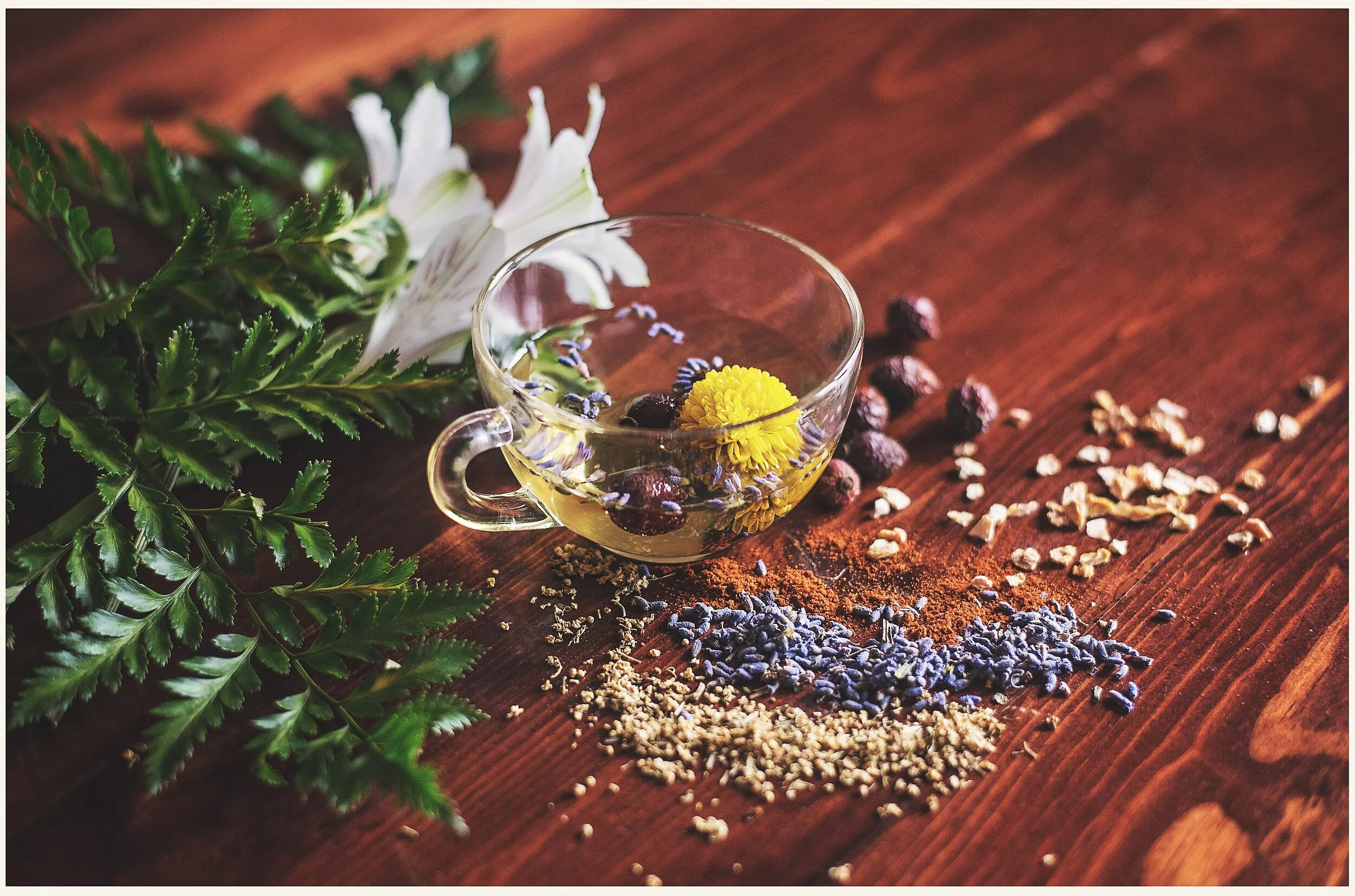The science of Ayurveda is great and ancient, although it is not commonly known amongst most people. In short, Ayurveda is an alternative medicine system that originated in India. This type of traditional medicine aims to holistically treat and heal not only the body but also the mind and spirit. This is can be achieved by changing your lifestyle - including your diet, the way to exercise, meditate and breathe.
Vata Season: Prepare Yourself For Autumn
Ayurveda Tips for Enjoying Spring
How to Make Ayurvedic Hair Oil
Health Tips For Pitta Constitution
General Health Tips
It's important for Pittas to keep cool by avoiding overexposure to direct sunlight and fried and spicy foods. Avoid alcohol and tobacco, overworking, and overheating. When aggravated, susceptible to feeling negative emotions like hostility, hatred, intolerance, and jealousy. Choose fresh vegetables and fruits that are watery and sweet, especially cherries, mangoes, cucumbers, water melon, and avocado. Have lots of salads with dark greens such as arugula, dandelions, and kale. Avoid conflicts. Cultivate the virtues of honesty, morality, kindness, generosity, and self-control.
Exercise
Pitta recommended classes at The Conscious Club
Benefit from cultivating a calm, relaxed attitude toward their practice and letting go of their competitive tendency.
Avoid : Heat, yoga forms that cause profuse sweating. You may want to schedule your yoga sessions during cooler times of the day, such as dawn or dusk.
We recommend the following type of classes:
Yin / Yang Yoga
Traditional Hatha Yoga
Meditation
Yin Yoga
Lu Jong Tibetan Healing Yoga
Tai Chi
Qi Gong
Morning Flow
Slow Flow
Hatha Flow
Events
The Zen Special: Yin Yoga & Yoga Nidra
Meditation & Music
Sound Journey
Deep Restorative Sessions
Kirtan: The Sound of Yoga
Yin & Chakra Journey
Ayurvedic Lifestyle Class
Sacred Cacao Ceremony
Hip Opener Series
Food
Pitta is oily, sharp, hot, light, spreading, and liquid. Foods that neutralize these qualities are foods that are dry, mild, cooling, grounding, stabilizing and dense. When we take a closer look at the qualities of various foods, we will have an improved understanding of these qualities so they can guide you in making specific dietary choices that will better support Pitta:
Favour cool over warm
Favour dry and dense over oily or liquid
Favour mild over sharp
Tastes to Favour and Avoid
Emphasize: sweet, bitter and astringent (flavour of dryness)
Minimize: pungent (spicy, hot), sour and salty
How to Eat
When it comes to reducing Pita, how we eat may be just as important as what we eat.
Pitta’s strong and sharp appetite has a general intolerance for skipping meals. A regular eating schedule of at least tree meals a day is recommended. Eating at the same time each day will also help balance pitta’s overactive digestive fire.
For Pitta it’s important to eat in peaceful environment. An environment where we can offer our full attention to the food we’re eating. This will help prevent overeating, which is common with pitta’s strong appetite.
What to eat
Ayurvedic food combining
Careful food combining can improve the quality of digestion, support the body in receiving a deeper level of nourishment, and positively impact our overall health. The Ayurvedic perspective is that each food has a distinct combination of tastes and energies – and a corresponding affect on both the digestive system and on the body as a whole. Combining foods with radically different energetics can overwhelm the digestive fire and can cause indigestion, fermentation, gas, bloating, and the creation of toxin
Notice which foods you combine that may be difficult to digest together, and how often you indulge in them. Become aware of how you feel afterwards. Do these choices affect your energy level, your digestion, your elimination, the coating on your tongue? Are particular combinations more noticeably influential than others? These are all important pieces of information.
When to eat
Breakfast is a very important meal when Pitta is elevated. Good choices are sweet, high in carbohydrates but also offer sustained energy.
Lunch is the main meal of the day, meaning it’s the largest and the most nourishing of the three. A wide variety of Pitta appropriate grains, beans, and vegetables are great building blocks for lunch.
Dinner is ideally smaller and lighter than lunch. But needs to be adequate to sustain pitta’s active metabolism.
Health Tips For Kapha Constitution
General Health Tips
It's important to be active on a daily basis as Kapha types are prone to sluggishness, depression, and being overweight. Getting out of the house and actively seeking new experiences is also recommended. Be receptive to useful change, be intentional in implementing life-enhancing actions. Choose foods that are light, warm, and spicy. Tea with dried ginger and lemon is a great pick-me-up for Kaphas. Avoid heavy oily and processed sugars, which are detrimental to Kaphas. Use lots of spices such as black pepper, ginger, cumin, chili and lots of bitter dark greens.
Exercise
Kapha recommended classes at The Conscious Club
Most of the standing poses are invigorating, especially if you hold them for a longer time. A stimulating, energizing yoga practice is ideal.
We recommend the following type of classes:
Kickboxing
Traditional Hatha Yoga
Slow Flow
Hatha Flow
Vinyasa
Lu Jong Healing Yoga
Kundalini Yoga
Morning Flow
Events:
Kickboxing XL
Sound Journey
Kirtan: The Sound of Yoga
Ayurvedic Lifestyle Class
Sacred Cacao Ceremony
Hip Opener Series
Meditation & Music
Food
Kapha is heavy, cool, oily, and smooth, so eating foods that neutralize these qualities – foods that are light, warm, dry, and rough – can help to balance excess Kapha. When we take a closer look at the qualities of various foods, we will have an improved understanding of these qualities so they can guide you in making specific dietary choices that will better support Kapha:
Favour light and airy over dense and heavy
Favour warm over cool or cold
Favour dry over moist and oily
Favour rough over smooth
Tastes to Favour and Avoid
Emphasize: pungent (spicy, hot), bitter and astringent (flavour of dryness)
Minimize: sweet, sour and salty
How to eat
When it comes to pacifying Kapha, how we eat can have a profound impact on our degree of success. Kapha does well to stick to three square meals per day, and sometimes just two meals are sufficient. It’s also best to eat your meals at consistent times from one day to the next. You can further kindle a sluggish digestive fire about 30 minutes before lunch and dinner by chewing a slice of fresh ginger (about the size of a nickel) with a pinch of sea salt, a few drops of lime juice. This helps to prepare the digestive system to receive food and to process it effectively. During meals, it is very important to eat in a peaceful environment and to give your full attention to the act of being nourished so that your body registers satisfaction. This will help reduce overeating and emotional eating, which often plague Kapha. Fast foods, sweets and excessive amounts of bread and other comfort foods can be especially Kapha provoking.
What to eat
Ayurvedic food combining
Careful food combining can improve the quality of digestion, support the body in receiving a deeper level of nourishment, and positively impact our overall health. The Ayurvedic perspective is that each food has a distinct combination of tastes and energies – and a corresponding affect on both the digestive system and on the body as a whole. Combining foods with radically different energetics can overwhelm the digestive fire and can cause indigestion, fermentation, gas, bloating, and the creation of toxin
Notice which foods you combine that may be difficult to digest together, and how often you indulge in them. Become aware of how you feel afterwards. Do these choices affect your energy level, your digestion, your elimination, the coating on your tongue? Are particular combinations more noticeably influential than others? These are all important pieces of information.
When to eat
Breakfast is often somewhat optional when kapha is elevated. Kapha benefits tremendously from the unforced, overnight fast between dinner and breakfast. If the appetite has not returned upon waking, it’s likely that a light breakfast of fresh fruit or tea will suffice.
Lunch is the main meal of the day, meaning it’s the largest and the most nourishing. Build your lunches around consuming lots of steamed and sautéed vegetables, and compliment them with beans, appropriate grains, non-yeasted breads.
Dinner is ideally significantly smaller and lighter than lunch. Soups and stews are often a wonderful choice because they are warm and nourishing, even when light. A smaller serving of lunch can often work, too. For some, especially when weight loss is indicated, it’s best to forego dinner altogether in favour of a healthy breakfast and lunch, or to eat a more substantial breakfast and make dinner the ultra-light meal of the day.
Kapha Constitution
Kapha Constitution
Kapha Dosha - Kapha is the sustaining force that upholds previous conditions, whether of health or disease. It's the energy that controls growth in the body. It supplies water to all body parts, moisturizes the skin, and maintains the immune system.
Kapha holds back and preserves both inhibiting the horizontal movement of Vata and the vertical movement of Pitta. It also provides the fuel that the other two doshas rely upon to produce their energy, which serves to stabilize them. We deal with Kapha third in order to guard our base.
Dosha In balance: Expressed as love and forgiveness.
Dosha Out of balance: Can lead to insecurity and envy.
Characteristics of Kapha mind/body type:
Easygoing, relaxed, slow-paced
Affectionate and loving
Forgiving, compassionate, nonjudgmental nature
Stable and reliable
Faithful
Physically strong and with a sturdy, heavier build
Have the most energy of all constitutions, but it is steady and enduring
Slow speech, reflecting a deliberate thought process
Slower to learn, but outstanding long-term memory
Soft hair and skin; tendency to have large "soft" eyes and a low, soft voice
Tend toward being overweight
May also suffer from sluggish digestion
Prone to depression
More self-sufficient
Gentle, and essentially undemanding approach to life
Excellent health, good immune system
Very calm
Strive to maintain harmony and peace in their surroundings
Not easily upset and can be a point of stability for others
Tend to be possessive and hold on to things.
Don't like cold, damp weather
Physical problems include colds and congestion, sinus headaches, respiratory problems including asthma, allergies, and atherosclerosis (hardening of the arteries).
Dosha Out of Balance:
Sluggish thinking, Dull thinking
Groggy all day
Apathetic, no desire
Depressed, Sad, Sentimental
Slow to comprehend, Slow to react
Procrastinating, Lethargy
Clingy, hanging on to people and ideas
Greedy, Possessive, Materialistic
Sleeping too much
Very tired in the morning, hard to get out of bed
Drowsy or groggy during the day
Weight gain, obesity
Mucus and congestion in the chest or throat
Mucus and congestion in the nose or sinuses
Nausea
Diabetes
Hay fever
Pale, cool, clammy skin
Edema, water retention, Bloated feeling
Sluggish digestion, food "just sits" in the stomach
High cholesterol
Aching joints or heavy limbs
Health Tips For Vata Constitution
General Health Tips
Maintain regular habits, try to eat and sleep at the same time every night. Get enough rest and choose foods that are warm, cooked, nourishing, and easy to digest. Sweet berries, fruits, small beans, rice, and all nuts and dairy products are good choices for Vata types. Exercise intensity should be moderate. A more meditative yoga, Tai chi, walking, and swimming are all good. Avoid strenuous and frantic activities.
Exercise
Vata recommended classes at The Conscious Club
Calming and grounding yoga poses are ideal (root your feet into the ground, reducing anxiety and stress).
Avoid : Fast-paced Vinyasas or flow sequences can aggravate Vata, which is prone to anxiety, overexertion, and fatigue.
We recommend the following type of classes:
Yin / Yang Yoga
Traditional Hatha Yoga
Meditation Monday
Yin Yoga
Lu Jong Tibetan Healing Yoga
Tai Chi
Qi Gong
Morning Flow
Slow Flow
Events:
The Zen Special: Yin Yoga & Yoga Nidra
Yin & Chakra Journey
Deep Restorative Sessions
Sound Journey
Kirtan: The Sound of Yoga
Ayurvedic Lifestyle Class
Meditation & Music
Sacred Cacao Ceremony
Hip Opener Series
Food
Vata is cool, dry, rough and light. Foods that neutralize these qualities are foods that are warm, moist, oily, smooth, and nourishing and can help to balance excess Vata. This section offers a closer look at the qualities of various foods. An improved understanding of these qualities can guide you in making specific dietary choices that will better support Vata:
Favour warm over cold
Favour moist and oily over dry
Favour grounding, nourishing and stabilising over light.
Favour smooth over rough (raw)
Tastes to Favour and Avoid
Emphasize: sweet, sour and salty
Minimize: pungent (spicy, hot), bitter and astringent (flavour of dryness)
How to Eat
When it comes to reducing Vata, how we eat may be just as important as what we eat. Vata is deeply soothed when we choose to eat in peaceful environment. An environment where we can offer our full attention to the food we’re eating. Routine itself balances Vata, so the practice of eating three square meals per day (at about the same time each day) further reduces Vata and helps to strengthen delicate digestion.
What to eat
Ayurvedic food combining
Careful food combining can improve the quality of digestion, support the body in receiving a deeper level of nourishment, and positively impact our overall health. The Ayurvedic perspective is that each food has a distinct combination of tastes and energies – and a corresponding affect on both the digestive system and on the body as a whole. Combining foods with radically different energetics can overwhelm the digestive fire and can cause indigestion, fermentation, gas, bloating, and the creation of toxin
Notice which foods you combine that may be difficult to digest together, and how often you indulge in them. Become aware of how you feel afterwards. Do these choices affect your energy level, your digestion, your elimination, the coating on your tongue? Are particular combinations more noticeably influential than others? These are all important pieces of information.
When to Eat
Breakfast is a very important meal when Vata is elevated. After an overnight fast, Vata needs real nourishment and a hearty breakfast is generally very stabilizing.
Lunch is the main meal of the day, meaning it’s the largest and the most nourishing of the three. Hearty grains, steamed and sautéed vegetables, appropriate breads, soups and stews are excellent foods for lunch. This is also the best time to enjoy a small salad, if you must have one.
Dinner is ideally smaller and lighter than lunch. But to soothe Vata, it needs to offer adequate nourishment. Soups, stews, or a smaller serving are good choices.
Vata Constitution
Vata Constitution
Vata Dosha - Vata, which relates to Prana or life-energy as a whole, is the moving force that keeps everything in the body circulating and working. It's the energy that controls bodily functions associated with motion, including blood circulation, breathing, blinking, and your heartbeat. Vata moves forward in a propulsive motion, making us active and on the go. We must deal with Vata first and make sure that our lives are moving in the right direction.
Dosha In balance: There is creativity and vitality.
Dosha Out of balance: Can produce fear and anxiety.
Characteristics of Vata mind/body type:
Creative
Quick to learn and grasp new knowledge, but also quick to forget
Slender
Tall and a fast-walker
Tendency toward cold hands and feet, discomfort in cold climates
Excitable, lively, fun personality
Changeable moods
Irregular daily routine
High energy in short bursts
Tendency to tire easily and to overexert
Full of joy and enthusiasm when in balance
Responds to stress with fear, worry, and anxiety, especially when out of balance
Tendency to act on impulse
Often have racing, disjointed thoughts
Generally have dry skin and dry hair and don't perspire much
Dosha Out of Balance:
Worried
Tired, yet can't relax, Fatigue, poor stamina
Nervous, Can't concentrate
Anxious, fearful
Agitated mind
Impatient, Antsy or hyperactive
Spaced out
Self-defeating
Shy, insecure, Restless
Cannot make decisions
Weight loss, under weight
Insomnia; wake up at night and can't go back to sleep
Generalized aches, sharp pains, Arthritis, stiff and painful joints
Agitated movement
Very sensitive to cold
Nail biting
Rough, flaky skin, Chapped lips
Fainting spells
Heart palpitations
Constipation, Intestinal bloating, gas, Belching, hiccups
Dry, sore throat, Dry eyes
Ayurvedic Seasonal Guides
Seasonal Guides
Ayurveda considers a seasonal routine an important cornerstone of health, year around. Balancing the nature of your local climate with lifestyle choices that offset the potential for seasonally induced imbalance is one of the simplest ways that you can protect your wellbeing. But, keep in mind that the seasons vary widely from one place to another, as do the qualities that they engender.
The seasons also affect a healthy practice. The season of cold dampness increases Kapha. The season of warm weather increases Pitta. The season of cool dryness increases Vata, as does the windy season. During the Kapha season, a practice that is more stimulating and warming is better. In the Pitta season, a practice that is cooling is best. In the Vata season, a calming practice supports greater health.
Fall guide
The fall brings with it a predominance of air element and prana, the vital breath, the subtle essence of life, is abundant in the atmosphere. Autumn is dry, rough, windy, erratic, cool, subtle, and clear. These are all qualities shared by Vata dosha, and because like increases like, autumn is considered a Vata season.
Winter guide
Everywhere around you the natural world is withdrawing, going dormant, and embracing a long, dark, season of slumber. There is a particular stillness that characterizes winter, and with it comes a subtle invitation to redirect our own energies.
Spring guide
Our physiology senses a natural opportunity for a fresh, clean start; our bodies are primed to lighten things up, cleanse ourselves of any accumulated imbalances, and rejuvenate our deepest tissues. As the natural world emerges from its long winter slumber, it is common to experience a renewed sense of joy and inspiration.
Summer guide
Summer, like each of the seasons, arrives with its own distinct personality. Depending on your constitution, summer may increase your internal sense of harmony, or it may aggravate one of your innate tendencies.
How Do I Determine My Ayurvedic Type?
How do I determine my type?
What is a dosha (constitution type) and how do I discover my dosha?
Ayurveda is based on the 5 elements and sees the world through the glasses of these elements. Everything consists of a combination of Ether, Air, Fire, Water and Earth.
How much you have of each of these elements, determines the qualities, but also what goes out of balance first and what symptoms they cause.
On the basis of the elements, Ayurveda works with three doshas/constitution types.
Ether and Air form Vatha, Fire and Water form Pitta, Water and Earth form Kapha.
How much you have of these elements determine your constitution. This is usually a combination of two doshas, like Vata and Pitta for instance. Once you know your constitution, you know also what elements get out of balance the quickest, so you can give it some extra attention.
Ayurveda makes a difference between two constitutions
Prakruti: the constitution in which you were born
Vikruti: your current constitution
We will look at your current constitution to see what is going on and check what can be balanced.
Most books and websites on Ayurveda will offer questionnaires that can be used to determine your mind/body constitution. You can try this test at Holistic Online, which is very detailed and thorough. Most questionnaires are very similar and will provide similar results. Please keep in mind that shorter questionnaires will give a more generalised and approximate result. Also, your body changes with age, seasons, and life situations so the results will change as well. Taking a few different questionnaires will give you a more definite result for your Dosha type.
Dosha Test English: Holistic Online
Dosha Test Dutch: Ayurvedisch Gezondheidscentrum Nederland
What Is Ayurveda?
What is Ayurveda?
Ayurveda, is the natural healing system of India, its traditional medicine going back to ancient times. The same great Vedic seers and sages that produced India’s original systems of yoga and meditation established Ayurveda as well.
"Ayurveda is a holistic science of health, focusing on maintaining a physically and emotionally balanced state."
Ayurveda originated as part of Vedic Science, an integral spiritual science that provides a comprehensive understanding of the entire universe of matter, mind and consciousness. Vedic Science includes yoga, meditation, mantra and astrology, and sets forth Ayurveda as its special branch for healing both body and mind. On this broad and profound background, Ayurveda includes herbal medicine, bodywork, psychology and spirituality.
“Ayurveda began about 5,000 years ago when Indian monks were looking for new ways to be healthy. Revering their bodies like temples, the monks believed that preserving their health would help them meditate and develop spiritually. Over thousands of years of observations, they gathered all their conclusions and advice and preserved it for future generations. This collection of knowledge came to be known as Ayurveda, the “science or knowledge of life.”
The History Of Ayurveda
Ayurveda is the traditional healing modality of the Vedic culture from India. It is said to be 2000 to 5000 years old, meaning it has stood the test of time. Ayurveda is a Sanskrit word that literally translates as “the wisdom of life” or “the knowledge of longevity”. In accordance with this definition, Ayurvedic medicine views health as much more than the absence of disease. The wise seers and sages of the time, intuitively understanding the physiology and workings of the mind-body-spirit long before the advents of modern medicine, explained the basic principles of Ayurveda.
Ayurvedic medicine was originally an oral tradition, taught and passed directly from teacher to apprentice, who would learn and work side by side. The oldest written codification of Ayurvedic principles is found in the Rig Veda. The fundamentals are then laid out in several major treatises, including the texts from Charaka, Sushruta, and Vaghbhat. There are also numerous other smaller works, written over time to explain the various branches of Ayurveda, which include disciplines such as general medicine, pediatrics, surgery, toxicology, fertility, and rejuvenation. The beauty in the way these have been explained is that they rely on basic principles which can be applied practically in any day and age.
Ayurveda has thus been passed down through the centuries as a complete healing system, evolving to meet the needs of the time, and yet remaining committed to its core principles. Various cultures have drawn upon the ideas of Ayurvedic medicine, and it continues to thrive in both the East and the West. In India, an Ayurvedic physician must undergo at least a 5 year post-graduate degree program (Bachelor of Ayurvedic Medicine and Surgery) to become qualified. In the West, Ayurveda is recognized as a Complementary and Alternative Health System by the National Institutes of Health, and is blossoming in various educational institutions.
Ayurveda is a more recent arrival on the Western scene than Yoga, following closely in its footsteps. Up to thirty years ago knowledge of Ayurveda was confined to a small number of people who knew the greater tradition behind Yoga. In the past few years, along with the explosion of interest in alternative and complementary medicines, Ayurveda has gained a growing recognition. It has now emerged as one of the most important systems of mind-body medicine in the world today.
Ayurveda offers a unique system of treatment based upon life-style adjustments. Its profound classification of mind-body types provides a clear assessment of individual constitution and how to treat it holistically. This makes Ayurveda an ideal practice for disease prevention, promotion of longevity, and increasing our creative powers.
How is Ayurveda different from modern medicine?
In Ayurveda, every individual is unique and there is no diet or lifestyle routine that works for everyone.
Prevention is key. Ayurveda focuses on providing specific advice and guidance on how to maintain physical and emotional health.
Food and lifestyle routines are considered the most important medicine. If you come to an Ayurvedic doctor with a complaint, you are more likely to leave with a recipe than with a prescription for pills.
How Does Ayurveda Work?
How does Ayurveda work?
Ayurveda is based on the 5 elements and sees the world through the glasses of these elements. How much you have of each of these elements, determines the qualities, but also what goes out of balance first and what symptoms they cause.
The Five Great Elements
Ayurveda believes that everything in this universe is made up of five great elements or building blocks. These are earth, water, fire, air, and ether.
Earth represents the solid state of matter. It manifests stability, permanence, and rigidity. In our body, the parts such as bones, teeth, cells, and tissues are manifestations of the earth. Earth is considered a stable substance.
Water characterizes change and represents the liquid state. Water is necessary for the survival of all living things. A large part of the human body is made up of water. Our blood, lymph, and other fluids move between our cells and through our vessels, bringing energy, carrying away wastes, regulating temperature, bringing disease fighters, and carrying hormonal information from one area to another. Water is a substance without stability.
Fire is the power to transform solids into liquids, to gas, and back again. In other words, it possess power to transform the state of any substance. Within our bodies, the fire or energy binds the atoms together. It also converts food to fat (stored energy) and muscle. Fire transforms food into energy. It creates the impulses of nervous reactions, our feelings, and even our thought processes. Fire is considered a form without substance.
Air is the gaseous form of matter which is mobile and dynamic. Within the body, air (oxygen) is the basis for all energy transfer reactions. It is a key element required for fire to burn. Air is existence without form.
Ether is the space in which everything happens. It is the field that is simultaneously the source of all matter and the space in which it exists. Ether is only the distances which separate matter. The chief characteristic of ether is sound. Here sound represents the entire spectrum of vibration.
Every substance in our world is made up of these five substances. All substances can be classified according to their predominant element. For example, a mountain is predominantly made up of earth element. A mountain also contain water, fire, air and ether. But these elements are very small compared to the earth. So, its classification is the earth.
Ayurveda defines a human as the assemblage of the five great elements plus the "immaterial self."
Doshas / Constitution Types
On the basis of the elements, Ayurveda works with three doshas/constitution types.
Ether and Air form Vata, Fire and Water form Pitta, Water and Earth form Kapha.
Doshas are the energies that make up every individual, which perform different physiological functions in the body.
The three doshas are always intertwined in what they do:
• Vata is the carrier
• Pitta pushes or provokes
• Kapha strengthens or resists



















